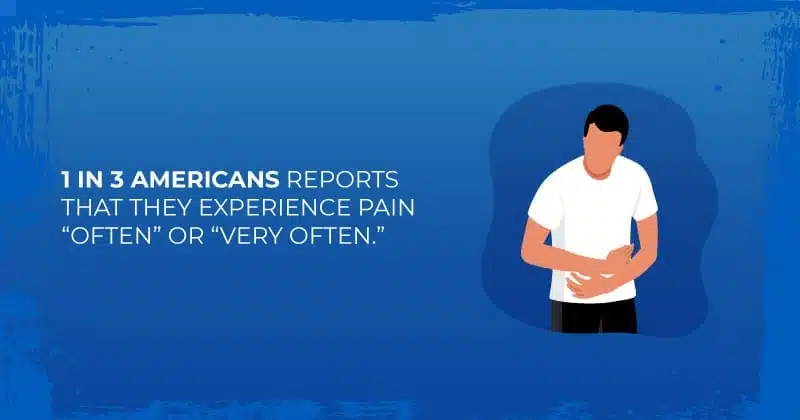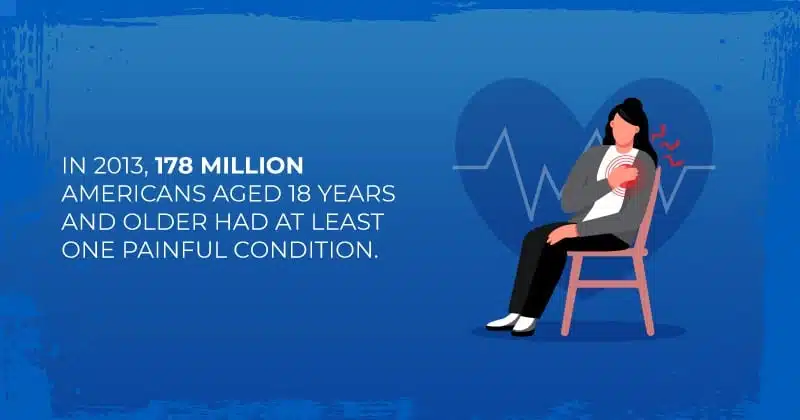

Chronic Pain: What It Is
and How Proper Testing Helps
The information presented on this page is an overview of the average evaluation of chronic pain and is offered here as a resource. At J. Flowers Health Institute, our evaluations and treatment plans are customized and tailored to each individual’s needs. We specialize in providing a comprehensive team approach to your care. Our evaluations may include neuropsychological and medical testing, brain mapping, and a chronic pain assessment for help diagnosing your symptoms to provide the holistic care you deserve.
If you would like to learn more about J. Flowers Health Institute, please do not hesitate to reach out.
We welcome any questions you have: 713.715.1618.
Table of Contents
Reach Out to Learn More
Contact our concierge team and allow us to tailor your treatment today
J. Flowers Health Institute's Dedication to Pain Management
Prioritizing both your mental and physical well-being, J. Flowers Health Institute is wholly equipped to diagnose, manage, and treat chronic pain within a supportive and serene environment.
If chronic pain is affecting your life, Dr. James S. Flowers and his skilled team of professionals are ready to help you find the relief you deserve. We can help you understand your symptoms and how proper testing can make a difference in your treatment.

Prevalence of Chronic Pain
Chronic pain (long-term pain) affects about 40 million people in the US.1
Some sources say the numbers could be as high as 100 million. Beyond the debilitating personal effects, this type of pain costs the US over $600 billion every year.2
Pain is a subjective experience. What’s painful to one person might be just a slight discomfort to another. That said, pain that lasts for long periods could be crippling, regardless of its severity.
Is Chronic Pain More Common in the United States?
People in the U.S. report having more pain than people in other countries. 1 in 3 Americans reports that they experience pain “often” or “very often.” In Croatia, the proportion is only 1 in 10 people.3 In the U.S., 126.1 million adults experienced some pain in the past three months. Among them, 10.5 million had experienced severe pain every day.4 In 2013, 178 million Americans aged 18 years and older had at least one painful condition. This was up from 120.2 million in 1997.5Chronic Pain and Age
Intense pain can affect people of all ages, but it’s more common in older adults. About 50% of older adults living at home and up to 85% of older adults living in care facilities experience chronic pain.6
But chronic pain isn’t just an issue for older adults. Young people can experience chronic pain too. It’s estimated that 5% to 8% of children and adolescents worldwide have long-lasting pain. This shows that this pain is a lifelong issue, one that can start early and continue as individuals age.7
Share This Article
LinkedIn
Facebook
Twitter
Categories
Top Blogs
Recent Post
What Is Pain?
The International Association for the Study of Pain (IASP) defines pain as “an unpleasant sensory and emotional experience associated with actual or potential tissue damage, or described in terms of such damage.”8
In layman’s terms, pain is an experience that causes discomfort. It may be due to an injury or to the brain’s inability to process pain signals properly. Pain may vary in severity, location, and the involvement of body parts.
Some pain may be limited to the area of injury, while some pain may affect the entire body. A headache involves only the head, and a stomachache affects only the belly.
What Types of Pain Are There?
People use different terms to describe their pain. Some of them include:
- Burning
- Sharp
- Dull
- Intense
- Aching
- Cramping
- Shooting
- Stabbing
Depending on your symptoms and severity, your pain can also change between these descriptions. This is especially true if you’re experiencing multiple types of pain.
What Is Chronic Pain?
Chronic pain is a type of pain that persists for at least three months. Depending on the cause, it may last up to six months or even longer.
Some examples of long-lasting pain are:
- Lower back pain
- Cancer pain
- Arthritis pain
- Neurogenic pain (pain due to nerve damage in the brain or other body parts)
- Psychogenic pain (pain due to faulty processing of pain signals by the brain)
A person may have more than one chronic pain condition at a time.
What Causes Chronic Pain?
Examples of the conditions that cause long-lasting pain include:
- Chronic Fatigue Syndrome: Thich causes extreme fatigue and unexplained pain.
- Endometriosis: This is a painful condition in females, in which the cells that line the inside of the uterus grow outside of the uterus.
- Fibromyalgia: This causes diffuse pain throughout the body.
- Inflammatory Bowel Disease (IBD): This is a long-term disorder that can cause inflammation in any part of the digestive tract.
- Interstitial Cystitis: This causes mild to severe persistent pain in the urinary bladder.
- Temporomandibular Joint Dysfunction: This condition causes severe pain and stiffness in the jaw.
- Vulvodynia: Vulvodynia is a painful condition of females which causes unexplained pain in the areas surrounding the vaginal opening.
The Effects of Chronic Pain on Physical and Mental Health
Persistent pain can have very real effects on your day-to-day life and your mental health. Physically, you might have low energy, trouble sleeping, or a decreased appetite. Chronic pain can interfere with your daily activities, making it hard to work, take care of your home or family, or do things you enjoy.
Moreover, you are more likely to be depressed, anxious, and irritable. Chronic pain causes a threefold increase in the risk of anxiety, and also in the risk of mood disorders such as depression.9
About 10% of people who die by suicide have persistent pain.10 In addition to the way chronic pain negatively impacts an individual’s quality of life, this may be partly because people with long-term pain have easy access to opioids.
What Makes Pain Chronic?
Pain is a complex condition. It has both physiological and psychological components. When a person sustains an injury, damaged tissues send pain signals to the brain.
This is the body’s way of preventing further tissue damage. Pain signals that reach the brain stimulate nerves, causing an unpleasant sensation called pain.
In some cases, the brain fails to process the pain signals properly and continues to feel the “pain” even after the injury has resolved.
Over time, nerves that send pain signals become more efficient. It means they will send more intense signals than they should.
Many lifelong conditions, such as cancer and diabetes, cause widespread tissue and nerve damage. Both of these conditions can cause long-lasting pain.
Acute Pain vs. Chronic Pain
Acute pain and chronic pain are different. Acute pain is a normal response to injury. It starts suddenly and it usually goes away when the injury heals. Acute pain is like a warning signal that tells you when something is wrong.
Some common causes of acute pain are:
- Surgical or dental procedures
- Bone fractures
- Burns
- Cuts
- Labor and childbirth
What Constitutes Chronic Pain?
Chronic pain usually lasts three to six months. However, some painful conditions may persist for years. Even after an injury has healed, chronic pain cain remain. Sometimes, chronic pain can even occur without any clear cause. Chronic pain is not just a symptom of another condition – it’s a condition on its own.Chronic Pain vs. Chronic Pain Syndrome
Chronicpain can sometimes lead to a condition called chronic pain syndrome. When you have chronic pain, the pain is the main problem. However, when you have chronic pain syndrome, the pain is just one part of the problem.
Chronic pain syndrome can affect all parts of your life. It can affect your physical health, causing you to feel tired or weak. It can affect your mental health, leading to depression or anxiety. It can even affect your social life, making it hard to work or maintain relationships.
What Causes Chronic Pain?
Several conditions can cause persistent pain. The top three causes are osteoarthritis, rheumatoid arthritis, and fibromyalgia.11
Fibromyalgia
People with fibromyalgia have unexplained pain in almost every part of their bodies. No one knows what causes fibromyalgia
Nonetheless, scientists think an imbalance of certain brain chemicals may play a critical role. Fibromyalgia can cause tender spots, muscle pain, headaches, long-lasting back pain, or neck pain.
Rheumatoid Arthritis
Rheumatoid arthritis (RA) causes persistent aching that affects more than one joint. Hands, wrists, and knees are the most commonly affected joints.
People with RA often have other symptoms, such as joint stiffness, swelling, and fever. Rheumatoid arthritis unfortunately does not have a cure.
Osteoarthritis
Osteoarthritis (OA) causes severe intermittent or persistent aching in the knees, hips, spine, and feet. Other symptoms include joint stiffness, swelling, and limited joint mobility. Like RA, there is also no cure for OA.
Thus, people with OA and RA might have some level of long-lasting pain throughout their lives.
According to the CDC, 25% of adults with arthritis (15 million adults) have severe pain in their joints.12
Multiple Sclerosis
Multiple sclerosis (MS) is a disease of the brain and the spinal cord. In people with MS, the immune system damages the protective covering of the nerves.
As a result, the brain cannot effectively communicate with the body. MS causes pain in the legs, feet, arms, and hands.
People with MS report experiencing burning, prickling, or stabbing pain almost every day.13
Sciatica
Sciatica causes mild to sharp burning pain that travels from the lower back to the buttocks. Unlike acute sciatica, chronic sciatica persists for three months or longer. The condition is more common in adults aged 40 or older.
Carpal Tunnel Syndrome
Carpal tunnel syndrome (CTS) causes pain and numbness in the thumb and in the index, middle, or ring fingers. The common causes include repetitive movements of the hand, rheumatoid arthritis, diabetes, and an underactive thyroid gland. Some women may have CTS during pregnancy.
Traumatic Injury
12 to 40% of cases of chronic pain have a history of physical trauma or injury. Likewise, 15% of people hospitalized after serious injury report chronic pain within the first year.14 Scientists do not know how an injury can lead to persistent pain.
Nonetheless, they believe several factors may increase the risk. These include pre-injury depression, anxiety, and alcohol use, as well as a history of persistent pain. Those who have sustained multiple injuries may be at a higher risk.
Back Injuries
Back injuries are one of the most common causes of chronic back pain. Heavy lifting, traffic crashes, or high-impact activities can cause back injuries. The lower back is most likely to be affected by such injuries.
Combat Injuries
Over half of war-related injuries result from explosive devices, landmines, and shrapnel.15
Almost all injured soldiers complain of pain, and many of them have traumatic brain injury (TBI). TBI can cause chronic headaches. Delayed wound healing and repeated injuries also account for persistent pain in many injured soldiers.
Sports Injuries
Chronic pain from sports injuries is not a new phenomenon. Studies reveal that 1 in 2 retired football players experience chronic pain. Besides, they also have sleep problems and mild depression. Both of these factors can contribute to chronic pain.16
An active athlete is continuously exposed to high-risk situations, such as repetitive impacts. They are always under pressure to perform well, and this can take a toll on their health.
Can Being Overweight Cause Chronic Pain?
Obesity does not directly cause chronic pain, but it can increase the risk. About 4 in 10 people who fit the definition of obese also experience long-lasting pain of moderate to severe intensity.17
Furthermore, people who are severely overweight are more likely to have conditions that may cause long-term pain, such as diabetes, arthritis, and fibromyalgia.
Who Suffers From Chronic Pain?
Anyone can have chronic pain. Children and teens are more likely to experience headaches, abdominal pain, and leg/hand pain.
Adults usually complain of joint pain, low back pain, and neurogenic pain. With that being said, some people can be at a higher risk due to their age, gender, and profession.

Veterans
Long-lasting pain is more common in veterans than in nonveterans. According to a National Veterans Affairs Study:
- 1 in 10 have severe persistent pain
- 1 in 10 have severe persistent pain
Veterans, especially those who have recently served in a war, report a variety of causes for their pain, including multiple injuries, brain trauma, and injuries to the muscles and bones.
Athletes
Chronic pain is common among gymnasts, soccer players, runners, and basketball players.
The most commonly reported persistent pain conditions in athletes are:
- Lower back pain
- Leg pain
- Stress fractures (cracks within a bone)
- Tendinitis (swelling of the tendon, which is a band of fibrous tissues that holds muscles and bones together)
- Diabetes
- Brittle bones
- Recurrent fractures
- Narrowed spinal canal, which presses the nerves that travel through the lower back into the legs
Seniors
Increasing age is the single most significant risk factor for chronic pain. According to BMJ, 33% of people older than 65 years have long-term pain.18 Studies also suggest that pain is most severe in adults aged 45 to 65 years.19
Common conditions that cause chronic pain in older adults are:
- Cancer
- Arthritis and gout
- Heart disease
- Kidney disease
- Damaged nerves
- Stroke
- Shingles
Women
Men and women perceive pain differently. Several factors contribute to this difference. These include hormones, menstruation, puberty, and reproductive status.
Women also have a higher risk of developing disorders that cause chronic pain. Examples of such conditions include:
- Arthritis
- Brittle bones
- Migraines
- Irritable bowel syndrome (IBS), which causes mild to severe stomach cramps
How Is Chronic Pain Diagnosed?
Diagnosing chronic pain is not easy, as there are no tools to quantify pain. Diagnosis often involves a series of tests and procedures, as well as a review of symptoms and medical history.
A doctor will first ask questions about the symptoms and factors that cause pain. These questions may include:
- When did you first begin having pain?
- How do you describe your pain? (shooting, burning, cramping, stabbing, dull, or sharp?)
- Have you had an injury in the affected part?
- Does any activity relieve your pain or make it worse?
- Do you have a history of mental illness, such as depression or anxiety?
- Where do you rate your pain on a scale of 0 to 10?
Then, they may order tests to identify physical causes that might be behind the pain. Some of the possible tests include:
Blood Testing
Blood tests are useful in the diagnosis of infections and inflammation. People with infection or inflammatory disorders have high levels of white blood cells, and also of inflammatory substances such as the C-reactive protein (CRP).
A blood test can also help determine if there is the presence of rheumatoid arthritis (RA), gout, or cancer. If RA is present, the blood analysis will show positive results for specific proteins called rheumatoid factors.
Urine Testing
Urinalysis is most commonly used to check if a patient has gout. Gout is a type of arthritis that causes high blood levels of uric acid. A doctor may also order a urine test for a patient who uses a narcotic painkiller to relieve chronic pain.
Testing Spinal and Brain Fluid
Sometimes, doctors need to test the fluid in your spine or brain to find out what’s causing your chronic pain. This is called a lumbar puncture or spinal tap. The test can show if you have an infection, like meningitis, or a condition like multiple sclerosis.
Both of these can cause chronic pain. The test can also show if you have inflammation or bleeding in your brain or spine, which can also lead to chronic pain.
Musculoskeletal and Neurological Exams
A musculoskeletal assessment checks the patient’s posture and joint mobility, as well as looking for swellings in the affected area. It may also be used to diagnose carpal tunnel syndrome.
Sometimes, the test may involve a detailed spine examination to identify spinal deformities and gait abnormalities.
A neurological examination assesses muscle strength, reaction to touch, balance, and sensation. Moreover, it may also test memory, alertness, mood, and behavior.
Imaging
Imaging tests provide detailed pictures of internal organs and activities inside the body. A doctor can use these tests to:
- Identify fractures or inflammatory changes in the bone
- Obtain details of a bone and surrounding structures
- Tell the difference between cancerous growths, infections, or fractures
- Identify nerve damage
X-Rays
An X-ray uses a small amount of radiation to create pictures of the inside of your body. It can show if you have an injury or disease in your bones that could be causing your pain. For example, an X-ray can show if you have arthritis, a broken bone, or a tumor. All of these can cause chronic pain.MRI
An MRI scan uses a strong magnetic field and radio waves to create detailed images of internal organs. An MRI helps diagnose the following conditions:- Chronic low back pain
- Fibromyalgia
- Osteoarthritis
- Chronic migraine
- Chronic pelvic pain
- Peripheral neuropathy (damage to nerves that lie outside the brain and spinal cord)
Electrodiagnostic Procedures
Two common tests include:
Electromyography (EMG)
An EMG helps diagnose disorders of muscles and nerves. It records electrical activity in the muscles. Thus it helps find out how electrical signals pass from nerves to muscles. A patient may need an EMG if they have numbness, muscle weakness, tics, or muscle pain. Electromyography may be used to identify some conditions that can cause chronic pain, such as:- Carpal tunnel syndrome
- Amyotrophic lateral sclerosis (ALS)
- Radiculopathy (pinched nerves in the spine)
- Muscular dystrophy (a genetic disorder that causes a gradual loss of muscle mass)
Nerve Conduction Study (NCS)
A nerve conduction study measures the speed with which electrical signals pass through a nerve. NCS is a valuable tool to identify:- Carpal tunnel syndrome
- Herniated disk disease, which causes lower back pain
- Abnormalities in the sciatic nerve
Pain Management
Many disorders that cause chronic pain have no cure. Luckily, several treatment options are available. Pain treatment primarily focuses on treating the underlying medical condition responsible for pain.
A comprehensive treatment plan addresses both physical and psychological factors that contribute to pain.
For this, different health professionals work together to design a plan tailored according to individual needs. A combination of medications, lifestyle changes, and behavioral therapies is perhaps the best approach.
What Does Pain Management Do?
Chronic pain treatment aims to:
- Improve mobility as much as possible
- Maintain quality of life with the lowest possible dose of medication
- Reduce the risk of pain-related psychiatric problems such as depression and anxiety
Pain Relievers
There are two main types of pain relievers: non-opioids and opioids.
Non-Opioids
Nonsteroidal anti-inflammatory drugs (NSAIDs) are the primary treatment for chronic mild to moderate pain. Some examples of NSAIDs are naproxen, ibuprofen, and aspirin. NSAIDs work by blocking the production of substances that cause pain and swelling. Acetaminophen (Tylenol) is similar to NSAIDs, but it works differently. It may block the production of inflammatory chemicals in the brain.Opioids
Opioids, or narcotics, are powerful pain relievers. They are used to treat moderate to severe pain. Narcotics act by blocking pain signals from reaching the brain. Opioid use has surged during the last few decades. In 2015, doctors prescribed three times as much opioid medication for chronic pain as they did in 1999.20 These drugs are highly addictive, and abuse is common. Most doctors prescribe narcotics when non-opioid pain relievers fail to provide the desired benefits. Examples include:- Buprenorphine
- Fentanyl patch
- Hydrocodone
- Oxycodone
- Hydromorphone
- Methadone
- Morphine
- Tramadol
Anticonvulsants
Anticonvulsants, or anti-epileptics, primarily treat seizures. They may also relieve pain associated with nerve damage and fibromyalgia.
Examples include:
- Gabapentin
- Pregabalin
- Carbamazepine
- Lamotrigine
Muscle Relaxants
When it comes to using muscle relaxants for chronic pain, expert opinions are divided. Moreover, only a few studies support their use in people with persistent pain. It is important for a person who is thinking of using any of these drugs to first consult their doctor.
Corticosteroids
Corticosteroids are hormone-based drugs that reduce inflammation. They occur naturally in the body, but some corticosteroids can be synthesized in the lab. Injectable steroids may help relieve chronic pain due to pinched nerves or joint disorders.
It’s important to have medical guidance if taking these substances. In 2014, the FDA reported that injectable corticosteroids might cause paralysis and death.21
Antirheumatic Agents
Antirheumatic medications are used to control the symptoms of rheumatoid arthritis (RA). They suppress the immune system and help reduce damage to the joints.
Examples include:
- Methotrexate
- Leflunomide
- Hydroxychloroquine
- Sulfasalazine
Antidepressants
Antidepressants can help relieve mental health disorder symptoms, but they can also relieve chronic pain. They can be useful in treating pain due to arthritis, migraine, nerve damage, and fibromyalgia.
These medications work by increasing the levels of brain chemicals such as serotonin, dopamine, and norepinephrine. They may be used even when a person shows no signs of depression.
Alternative Treatments
Alternative treatments may also help address pain. It’s always recommended to discuss any treatments with a doctor or medical professional. Remember, what works for one person may not work for another.
It’s recommended to start with the easiest alternative treatments and write down how they feel after a month of practice. If they are feeling better, they may consider continuing the treatment for an extended period.
Examples of Alternative Treatments
Below are some of the alternative pain treatments to consider:- Massage: This treatment may help relieve pain associated with RA and fibromyalgia.
- Acupuncture: This treatment may work for pain due to osteoarthritis and fibromyalgia.
- Meditation: Mindfulness meditation may help improve pain perception and can work to reduce depressive symptoms.
- Hypnosis: Hypnosis may be useful in treating cancer.
Psychological and Behavioral Treatment
Psychotherapy (talk therapy) is an integral part of chronic pain treatment. It has no direct effect on pain severity. However, it can help improve other pain-related conditions, including depression, anxiety, and fear of pain.
Two forms of psychotherapy have shown promising results in many studies. They are:
Acceptance and Commitment Therapy (ACT)
ACT is short-term psychotherapy. There are two approaches to pain perception in ACT. First, ACT teaches the patient to accept things that are beyond their control. Secondly, it encourages the patient to feel things as they are rather than questioning their existence. ACT may be useful in treating lower back pain, leg pain, and neck pain.Cognitive-Behavioral Therapy (CBT)
CBT educates people about the relationship between pain, mood, and behavior. It also teaches relaxation strategies. Patients will learn measures to replace distorted thoughts about pain with positive thoughts. CBT is likely to be most effective in treating chronic pain caused by:- Cancer
- Chronic migraines
- Fibromyalgia
- HIV/AIDS
- Irritable bowel syndrome
- Multiple sclerosis
- Osteoarthritis
- Rheumatoid arthritis
- Spinal cord injury
Why Is Proper Testing Key to Treating Chronic Pain?
Chronic pain is a complicated disorder. There is no specific tool for diagnosis. Likewise, available treatments often fail to produce favorable results.
Proper testing is essential in treating chronic pain because it helps identify the underlying cause of the pain. Chronic pain can be a symptom of many different conditions, and each one requires a different treatment approach.
Examples of Why Proper Testing Is Needed
For example, chronic pain caused by arthritis might be treated with anti-inflammatory drugs, while chronic pain from nerve damage might require different medications or therapies.
By identifying the root cause of the pain, doctors can create a treatment plan that directly addresses the problem, rather than just managing the symptoms.
Guiding Treatment Decisions
Once the cause of chronic pain is identified, proper testing can guide treatment decisions. For example, if testing reveals that a patient’s chronic pain is due to a herniated disc, a doctor might recommend physical therapy, medications, or in some cases, surgery.
On the other hand, if the pain is due to fibromyalgia, the treatment plan might include medications, lifestyle changes, and techniques to manage stress. Without proper testing, treatment would be more of a guessing game, which could lead to ineffective treatments and prolonged pain.
Monitoring Progress and Adjusting Treatment
Regular testing can help the doctor determine if the medication is working and if the dosage is correct. If the patient’s pain levels aren’t improving, the doctor might decide to try a different medication or add a new therapy to the treatment plan.
Without regular testing, it would be harder to tell if a treatment is working or if changes need to be made.

Discover the Root of Your Chronic Pain with J. Flowers Health Institute
Chronic pain can be more than just a physical discomfort. It can impact your emotional health, lifestyle, relationships, and overall well-being. Often, the cause of chronic pain remains a mystery, causing frustration and anxiety for those who suffer from it.
At J. Flowers Health Institute, we are committed to exploring the depths of your pain and finding the cause. Our “Living MRI” evaluation goes beyond the surface to accurately diagnose the root of your chronic pain, using a variety of techniques and disciplines.
Our thorough diagnostic evaluation may include:
- Comprehensive medical evaluation
- Chronic pain evaluation
- Neuropsychological testing
- Brain mapping
- Specialty physicians consult
- Nutritional and fitness evaluations
- Comprehensive report and action plan
Chronic Pain Conditions We Specialize In
We have a wealth of experience in diagnosing and treating a variety of chronic pain conditions, such as:
- Amplified Musculoskeletal Pain Syndrome
- Radicular Pain
- Rheumatoid Arthritis
- Spinal Stenosis
- Traumatic Injuries
- Carpal Tunnel
- Fibromyalgia
- Migraines
- Neurogenic and Neuropathic Pain
Let J. Flowers Health Institute Guide Your Healing Journey
J. Flowers Health Institute is equipped with a highly skilled team of professionals who understand the complex nature of chronic pain. We focus on you as a whole person, not just your symptoms, providing you with a comfortable and supportive environment to start your healing journey.
We believe that every person deserves a life free from chronic pain. Don’t let chronic pain dictate your life any longer – reach out to J. Flowers Health Institute today.
Resources
-
- https://nccih.nih.gov/research/results/spotlight/Prevalence-Profile-High-Impact-Chronic-Pain
- https://www.hsrd.research.va.gov/for_researchers/cyber_seminars/archives/2351-notes.pdf
- https://www.theatlantic.com/health/archive/2017/12/america-experiences-more-pain-than-other-countries/548822/
- https://www.ncbi.nlm.nih.gov/pmc/articles/PMC4562413/
- https://nccih.nih.gov/news/press/02122019
- https://magazine.medlineplus.gov/pdf/MLP_Fall_11.pdf
- https://www.ncbi.nlm.nih.gov/pmc/articles/PMC5184817/
- https://www.iasp-pain.org/Education/Content.aspx?ItemNumber=1698#Pain
- https://www.health.harvard.edu/mind-and-mood/depression-and-pain
- https://www.hsph.harvard.edu/news/hsph-in-the-news/suicide-rates-chronic-pain/
- https://www.uspharmacist.com/article/trends-in-chronic-pain
- https://www.cdc.gov/arthritis/pain/index.htm
- https://www.nationalmssociety.org/Symptoms-Diagnosis/MS-Symptoms/Pain
- https://academic.oup.com/painmedicine/article/14/3/336/1858823
- https://pubmed.ncbi.nlm.nih.gov/19557963/
- https://www.ncbi.nlm.nih.gov/pmc/articles/PMC7165032/
- https://www.ncbi.nlm.nih.gov/pmc/articles/PMC6676152/
- https://bestpractice.bmj.com/topics/en-us/694
- https://www.apa.org/pubs/journals/releases/amp-a0035794.pdf
- https://effectivehealthcare.ahrq.gov/products/opioids-chronic-pain/protocol
- https://www.frontiersin.org/articles/10.3389/fphar.2018.01229/full









